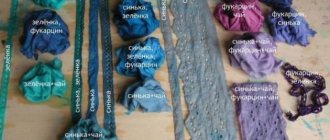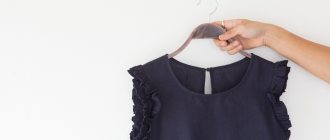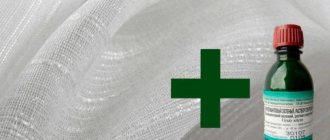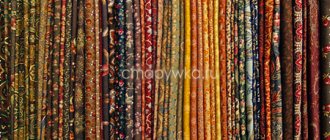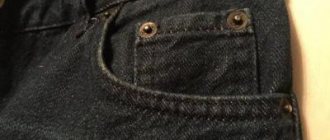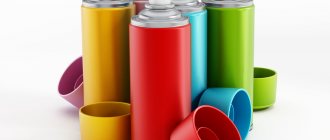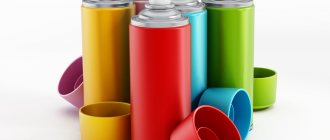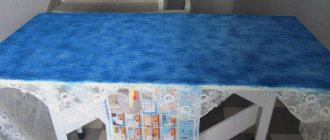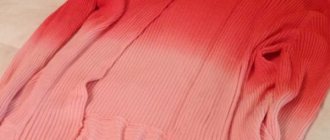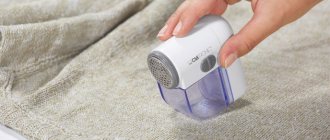How to dye a coat. True fashionistas tirelessly strive for change.
And sometimes the offers of the modern clothing market do not keep up with the irrepressible imagination and changing demands. It happens that the wallets of the beautiful customers themselves do not allow them to update the image according to their own whims, especially when it comes to clothes for the street. Ingenuity and skillful hands come to the rescue. And now, from a tired or stained or frayed coat, you get an interesting new thing that will make you happy! How to dye a coat at home a different color? If you find this difficult, use a dry cleaning service. We offer you simple step-by-step instructions.
Before painting
Before you start dyeing your coat, you should weigh the pros and cons, as there are always risks in this procedure. Are you sure you can dye your coat at home or should you take it to the dry cleaners where they can dye it themselves?
Then we proceed as follows.
Determining the composition of the fabric
Most often, the final result depends entirely on the quality of the material from which the coat is made. There may be the following options:
- Natural fabrics. They are best suited for repainting a different color and the risk of failure is minimal.
- Mixed. In this case, the original version will turn out to be somewhat paler than you expected.
- Synthetic. They stain poorly or not at all. Therefore, it is better not to take risks.
Important! Very often, careless manufacturers indicate on the tag the composition of the fabric from which the product is made. Please take this into account. And to protect yourself from surprises, try to initially dye a small piece of fabric that always comes with any item.
Deciding on the future color
It is best not to radically change the color. Choose the same or a few shades darker. For example, if your coat was red, then you can dye it the same or burgundy. For the experiment, that same spare piece of fabric will again come in handy.
Yellow and brown
Having decided to get solar coloring, our ancestors could use more than two dozen plants. Some of them were used in their entirety: immortelle, heather, cuff, navel, string. And in the genus of gorse, shrubs and subshrubs of the legume family, there is even a species that is called just that - dyeing. For the same purpose, flowers and leaves of goldenrod (also called golden rod), jumper (also having a second name - impatience), and sickle grass were used. Only flowers were taken if it was about the umbrella hawkweed and, oddly enough, the meadow cornflower, and also the horned frog. By the way, the leaves of birch and black grass (or verbolosis) were used. The zealous owners also did not forget about the root system of plants: sorrel and iris turned out to be useful here (it received a very affectionate nickname - iris). And the bark was taken from hazel and wild apple trees for dyeing purposes. Sometimes certain plant parts were chosen based on the material to be dyed. Thus, the leaves and stems of the moss moss (aka the ram), as well as the flowers of the rapeseed, were taken into account when working with wool, and the swimsuit was used only for canvas. Both yellow and brown tones can be obtained from the bark, leaves and berries of alder buckthorn. As experts note, the dye from this plant is very resistant to fading.
Basic painting rules:
- Only clean items should be dyed. Wash the product in advance, and immediately before the procedure, soak it in warm water.
- Painting the coat should be carried out following the instructions indicated on the packaging of the dye mixture.
- After completing the procedure, the product must be rinsed until the water becomes completely clear.
Important! The final rinse should be done by adding a few tablespoons of vinegar to the water.
How to dye a coat?
In order to repaint a coat a different color, you need the following equipment:
- Vinegar;
- Water;
- Rubber brush;
- Dye for clothes.
Important! You can determine the required amount of paint by weighing the coat. After this, find this parameter in the table on the package.
- Comb the product with a rubber brush.
- Dilute the dye in warm boiled water.
- Vinegar should be added to the resulting solution (the required amount is also indicated in the instructions).
- Next, you need to follow all the recommendations indicated on the packaging by the manufacturer.
- After finishing dyeing, the coat should be hung to dry outside or in a room with good air circulation.
Important! The only option when you can paint a coat a radically different color is the light color palette of this product. That is, if the coat is white or beige, then you can dye it either blue or pink.
Correct procedure
The coat is weighed to determine the required amount of paint and the instructions are carefully read. It says how much dry powder is needed for a certain weight. After this, you can proceed directly to the staining process, performing the following steps sequentially:
- Using a rubber brush, outer clothing should be cleaned of dirt. It is advisable to remove existing stains; not all dyes are able to hide them.
- The paint must be diluted in boiled water, and a bite must be added to the resulting solution. Its content must correspond to the quantity specified in the instructions.
- Follow the algorithm written on the packaging.
Dry painted items at room temperature away from heating appliances. They should not be exposed to direct sunlight. It is advisable to spread the coat on a horizontal surface, placing it on a sheet or hanging it on a hanger. You need to make sure that no smudges appear on it. By strictly following the steps indicated in the instructions, you will not get an unexpected result, and the coat will acquire a second life.
Repaint it black
In order to dye a coat black at home, you will need the following equipment:
- Wooden spoon with long handle;
- Laundry soap;
- Salt;
- Water;
- Soda;
- Washing powder;
- Fabric dye.
- Wash your coat using powder or a solution of soap and soda.
- Remove all buttons, snaps and other decorative items. This is necessary so that the painting is done evenly and there are no bright spots left.
- Prepare the dye according to the instructions.
- Wet the coat in warm water and quickly transfer it to a container with dye.
- Next, the solution should be heated almost to boiling. Adhering to this temperature regime, you should constantly stir it for about 20-25 minutes. This is necessary for uniform coloring.
- Pour in a saline solution in the proportion of 2 tablespoons of salt per 2 liters of water.
- Stir for about 20 minutes and remove the product from the dye solution.
- First, you need to rinse in warm water, gradually lowering the temperature to cold.
Types of Dyes
Universal paints are suitable for various needs. They can be used to paint both textile shoes and clothes. Household products are cheaper, but are not durable, while industrial paints hold up well and are designed for painting large volumes.
Let's figure out the best way to dye fabric at home.
Acrylic paints
Painting fabric with acrylic paints is popular among needlewomen. The dye can be diluted with water, but it is better to use a special solvent. You will also need a circuit to work.
Areas with acrylic paint are inelastic, and therefore the use of the composition for applying patterns on knitwear should be limited. The advantages of acrylic paints are a rich palette, brightness, metallic effect, durability and affordability.
Aniline dyes
For painting large canvases, aniline dyes are often used. They are suitable for natural and mixed fabrics where the synthetic content is less than 60%.
In order for the pigments to set, the product must be boiled. If you gradually lower the fabric into water during cooking, you will get a gradient pattern. After staining, fix it with vinegar.
Stamp inks
They are used primarily for marking linen or applying a logo to clothing. They are durable and do not fade. They can either apply a contour drawing or paint the fabric black, but the consumption of expensive paint in the second case will be significant.
The composition of stamp inks is alcohol, oil, water-glycerin.
Plastisol paints
Known as PVC paints, they do not contain solvents and harden at high temperatures. They belong to solid paints and can dye fabric in any bright color - green, yellow, red. Used in silk-screen printing.
Suitable for creating rich images. They can be used to paint both clothes and sneakers. Plastisol paints with reflective or fluorescent particles have gained popularity.
Natural paints
If store-bought dyes are not attractive, you can dye the fabric with natural dyes. Dyes are present in foods, flowers, leaves and twigs of plants. If you dye fabric with natural dyes, you will get an environmentally friendly material, although the coloring is not always rich and durable. Let's look at how to dye clothes using natural dyes.
| Desired color | Product |
| brown | oak bark, cherry branches, tea, coffee, horse sorrel root, onion peel (brown-red hue), alder leaves and bark; |
| blue | blueberries, buckwheat leaves, basma, cornflower inflorescences, blackberry fruits, sage stems and leaves; |
| in red | elderberry berries, beets, St. John's wort flowers, buckthorn berries, rowan bark, potassium permanganate, fucorcin; |
| in gray color | spruce cones, walnut shells, wild rosemary; |
| in green | rowan bark, sorrel leaves, bush elder, juniper fruits, bird cherry branches, horsetail stems, brilliant green; |
| in yellow | barberry bark and roots, pomegranate peel, acorns, turmeric, dandelion, tansy, chamomile, celandine. |
The final shade depends on the method of fixation, that is, etching, and the exposure time. Therefore, different shades can be obtained from one product.
For example, tea can color something brownish and yellow. And with the help of coffee you can dye fabric either taupe or beige. The procedure looks like this:
- brew coffee or brew instant coffee;
- add to a saucepan with water and bring to a boil;
- soak the product for 1 – 3 hours;
- rinse and soak in vinegar solution to fix.
You should not expect a dark coffee shade after the manipulations. The color will be beige or ecru.
Aerosol paints
Such products are based on a solvent. They are suitable for natural fabrics. Apply by spraying and dry in half an hour.
They do not require etching, but are not suitable for processing large areas. They are usually used for painting on canvas.
Glowing colors
Paints that glow in the dark contain phosphor particles.
Glowing paint should be applied to a dry and clean product. For application, use a brush, roller or stencil if the composition is not applied by spraying. Paint in 1 – 2 layers. The painted areas glow after complete drying.
Dyeing a coat in a washing machine
Using a washing machine greatly simplifies the process of dyeing a coat. Today, this is one of the most popular and simplest methods used to change the color of clothes. Therefore, in order for the initial result to please you and the product to be colored evenly, you must adhere to the following rules:
- The diluted ready-made color mixture should be poured directly into the drum.
- The temperature should be no more than 60-80 degrees. The longest cycle should be chosen. This is necessary so that the paint is distributed evenly.
Important! After you have completed the dyeing process, the washing machine should be run empty. This is necessary in order to completely eliminate any remaining paint that may remain.
- After painting, the product should be rinsed in a vinegar solution.
- If the dye is applied unevenly, and the color turns out to be streaky, then the operation should be repeated again.
- If the second attempt fails, the only way out is to paint the product black.
- After the coat has dried, it should be wiped with a dry cloth or cotton pad.
Important! After dyeing clothes in a washing machine, it is not recommended to wash white items for the first time.
Types of Dyes
The composition of the fabric and the purpose of the dyeing procedure will determine what type of dye will need to be used. In art and sewing stores you can purchase paint in the form of:
- powder;
- fabric markers;
- spray;
- coloring paste mass.
If you need to update the color or evenly tint the item, you should opt for powdered aniline dyes. They can be used in the washing machine, or you can dye the product by hand. If they are solving a more complex artistic problem, choose acrylic paints in any suitable release form. It should be remembered that the chemical composition of dyes is quite different and is not suitable for all types of clothing. More details about this are written in the instructions, which you should definitely read. How to dye clothes and what paint to choose? This is interesting: dyeing a down jacket.
Acrylic paints
Acrylic dyes cotton, natural silk, and wool well. It is better to check the possibility of dyeing synthetics in the instructions. This type of paint contains pigments that are harmless to humans, acrylic binders and water. The presence of the last component allows you to dilute the paint with water to obtain lighter shades
When choosing acrylic paint, you should pay attention to the markings. Only compositions marked “For fabric” are suitable for dyeing clothes.
You can paint things with acrylic without this mark, but then the result of the work will be unpredictable. Acrylic, when working with it, is easily washed off with water, but after drying it is firmly embedded in the fabric. Finished products are perfectly resistant to machine washing at 40 degrees, as well as hand washing in a basin, but the first few times it is better to wash the dyed clothes separately from other items. This dye is perfect for tie-dai and batik techniques and for making complex patterns on clothes, as it spreads moderately over the fabric during application.
Acrylic paint for fabrics
Aniline dyes
These paints are used for all types of natural fabrics, leather, as well as for mixed textiles, which contain more than 50% natural fibers. Recently, aniline pigments for synthetics have appeared on the market. The possibility of coloring artificial materials is indicated in the instructions. The dyes have an organic composition; dyed products do not have a toxic effect on the owner’s skin. The paints are sensitive to the sun and aggressive washing at high temperatures, but with proper care of the product they will delight the eye with bright colors for more than one season. Aniline dyes are widely used in the textile industry. For home use, powder and liquid forms of the dye are available, which are then diluted in water. In order for the paint to adhere to clothing, the item is boiled in a dye solution, then dried, steamed and washed several times to remove any remaining pigment. This pigment can be used to dye clothes in the washing machine.
Aniline dye for fabrics
Natural paints
This type of dye is suitable for all types of natural textiles, however, dyeing results are difficult to predict, so it is recommended to test the composition on a small area of fabric. Natural pigments are less resistant to washing powder and sunlight, but are less likely to cause allergic reactions. How can you dye clothes? The following colors are obtained naturally:
- red - from beets, blueberries, ripe elderberries;
- yellow - from wormwood branches, orange peel, ground turmeric;
- ocher - from celandine juice;
- brown - from tea, coffee, henna, onion peels and oak bark;
- blue - from blackberries, a mixture of spinach and curcumin;
- green - spinach, elderberries;
- gray - from bearberry, broom.
Clothes are tinted in the prepared broth, the temperature of which is maintained at around 60 degrees. After some time, the paint is fixed with special substances (ferroammonium and potassium alum, copper sulfate, etc.), then rinsed and dried. Dyeing clothes with natural compounds is a very labor-intensive, but very exciting process, which is suitable for creating plain clothes in boho and folk styles.
Natural dyes
Useful tips and tricks
So that everything works out for you, and the repainting process does not cause unnecessary trouble, we offer you some useful tips:
- Try to determine the required amount of dye as accurately as possible.
- The container in which you prepared the coloring solution is no longer suitable for cooking and storing food.
- Always wear gloves.
- If the coat is wool, then you need to dissolve the paint in very hot water.
- If you plan to alter this item in the future, then you can tear it apart and paint it in parts.
- To prevent the product from burning during the process, you can put a wooden board on the bottom of the container.
What care should be taken after coloring?
In order for the result to last for a long time, and the product not to fade after the first wash, you should follow several rules:
- Do not dry the dyed item in direct sunlight as the color may fade.
- For subsequent washes, add vinegar during the rinse phase.
- Use laundry detergent designed exclusively for colored fabrics.
So that everything works out for you, and the repainting process does not cause unnecessary trouble, we offer you some useful tips:
- Try to determine the required amount of dye as accurately as possible.
- The container in which you prepared the coloring solution is no longer suitable for cooking and storing food.
- Always wear gloves.
- If the coat is wool, then you need to dissolve the paint in very hot water.
- If you plan to alter this item in the future, then you can tear it apart and paint it in parts.
- To prevent the product from burning during the process, you can put a wooden board on the bottom of the container.
Coat dyeing
Has your coat lost its color over time, but purchasing a new one wasn’t in your plans? Or do you want to experiment and get an original and beautiful thing that you definitely won’t see on anyone else? All this is possible at minimal cost and will not require a lot of effort if you know exactly how to repaint a coat yourself. This way, you won’t need to take your coat to the dry cleaner, because you can easily perform all the simple procedures at home.
What do I need to dye my coat?
This procedure requires a few simple ingredients. You will need the following:
- dye of the desired color, special, for clothing - it can be purchased in stores;
- clean rubber brush;
- water;
- vinegar.
How to dye a coat to make it look better?
To begin with, before you begin the process of dyeing your coat, decide exactly what you want to change about your coat and how you want it to look. It will be easy for you to repaint an initially light coat; it will easily take on a new color, but with dark ones it will be much more difficult, especially with a black coat. Therefore, fabrics of beige, white and related shades are ideal for experiments. Black can be repainted in some rich dark color: blue, red, burgundy, dark green.
Find out if your coat can be dyed. This is done as follows: first, you will find out what fabric your item is made of, whether the coat can be boiled, and when purchasing a dye, be sure to read all the recommendations for use - it will indicate for which fabrics it can be used.
A little advice
: It is best to purchase clothing paint at a specialized household chemicals store.
When deciding to repaint your coat, you must have an already prepared product. Preparation consists of removing stains and completely cleaning the coat, otherwise the coloring cannot be uniform.
In order to determine how much paint you will need to repaint your coat, first weigh the coat in a dry state and remember or write down the resulting figure. Now refer to the instructions for the dye you purchased; it will indicate how much of this product is needed in order to dye a certain amount of clothing.
How to dye a wool coat?
For a wool coat, the dyeing process will look like this. First, dilute the required amount of dye in boiled water, add the appropriate amount of vinegar there - how much you need to add will be indicated in the instructions, then follow all the steps indicated in the instructions, since the algorithm of actions for a certain dye may differ slightly from the usual.
If you want the result to be as permanent as possible, use the following method to redye your coat. You will need a container of water large enough to hold the coat. Add a two percent vinegar solution there and mix with water. As soon as you complete the process of dyeing your item, rinse it in this water-vinegar solution. Typically, manufacturers indicate that after painting the item should be rinsed until the water from it stops being colored and becomes clear. Therefore, how you achieve this result is to put your coat in a vinegar solution.
You will need to dry your coat naturally. Squeeze it lightly so as not to deform the product, hang it on hangers and let it dry. So you got an updated item with an interesting color - the one you chose yourself.
The dyed coat will then need to be washed only at a minimum water temperature and by hand.
Instructions
Please note that it is not easy to dye on your own, so if you are not confident in your abilities, it is best to seek help from specialists from any dry cleaner. There they will select the optimal dye for your top, taking into account all the wishes and recommendations of the owner.
If you nevertheless decide to try to update the coat yourself, then pay attention to the fact that it is easiest to repaint things in black and. For colored paint it is much more difficult to choose the appropriate paint. Therefore, it is quite possible that the best option would be to dye a light coat dark.
Check the product label to make sure what material it is made of. As a rule, coats are made from wool, tweed, and wool blend fabric. For repainting such items, wool dye, which is sold in specialized household chemical stores, is quite suitable.
Before you begin preparatory work for painting, put your outerwear in order. Clean it thoroughly from dirt with a rubber brush or damp cloth. It is also advisable to remove all stains, because exposure to dye does not guarantee that the stains will not be visible.
To determine the amount of dye needed, weigh your clothing and read the instructions on the dye package. It should indicate the required amount of dry powder for a certain weight of clothing. To treat a product with wool dye, dilute it in boiled water. Add the required amount of vinegar to the solution, which is also discussed in the instructions, and proceed according to the algorithm specified in it. You need to fix the result with a 1-2% vinegar solution. After dyeing, dry the coat in the open air.
Sources:
- where can you dye a coat
It happens that your favorite outfit fades in the sun or loses its original color over time. You can make your own clothes. Try updating or completely changing the tone of the fabric using an industrial or natural dye.
You will need
- Industrial dye (with instructions) or natural
- Specialist consultation
- 2 tablespoons of ammonia
- 50 g salt
- Large capacity
- Clothes tongs
- 10 g vinegar
- Thick spin cloth
Instructions
Read the information on the product tag. For dyeing to be successful, it is important to know the material used to make the clothes.
Industrial dyes are suitable for cotton, linen, wool, silk and some synthetic fabrics (nylon, nylon).
It responds quite well to dye - a material created artificially, but from natural cellulose.
Clothes made from mixed fibers are usually dyed with a mixture of dyes for cotton (linen) and nylon.
There are fabrics (such as lavsan) that are difficult to dye.
Consult your household chemicals retailer and fabric department consultant regarding paint selection. Try going to a specialized outlet for artists. They have a large selection of fabric dyes, including for delicate materials.
Beige or brown clothes can be soaked and rinsed in strong filtered tea or coffee.
Black and brown clothes can be refreshed by soaking them in strained tobacco infusion (3 teaspoons per liter of boiling water). You can simply wipe the item with a brush, moistening it in a tobacco solution.
Yellow or green fabrics are soaked for 6-8 hours in a decoction of onion peels and boiled in it for another 4 hours. You can also use a decoction of yarrow.
First of all, you will need to prepare your coat for painting: thoroughly clean and remove stains from its surface (if any). Buy suitable paint for clothes and a rubber brush. You will also need vinegar and water.
To buy a good paint that is suitable for your product, carefully look at the coat label. Usually there is information about the properties of the clothing fabric (as a rule, coats are made from wool, tweed, cashmere, wool blend). It is better to purchase paint at a special household chemicals store.
To measure the amount of dye needed, weigh the coat and then read the instructions for using the chemical. The technical documentation must specify the volumes of dry product designed to dye a certain mass of clothing.
If your coat is made of wool, dilute the dye in boiled water. Then add the required amount of vinegar there (this information is also presented in the instructions). Continue to act according to the algorithm specified in the accompanying document attached to the dye.
Over time, the coat changes color, it becomes pale, and spots appear that are difficult to get rid of. If your plans do not include buying a new piece of outerwear, do not despair, the situation can be corrected and you can dye your coat yourself at home. It will not take much effort and time, and there is no need to take it to the dry cleaner. The main thing is to strictly follow the instructions.
Video material
In order to give a second life to your outerwear, you will not need a lot of physical effort and material costs. With a little patience, you will end up with a completely new coat, albeit one with “old holes.” But only you will know about this!
The hero of the old film wanted “the same, but with mother-of-pearl buttons.” It happens that the thing you like is slightly different from what you need - for example, in color. And in general, products tend to lose their original color, fade in the sun or wear off over time! “BUBBLES” will help solve these and other problems with its textile dyeing service. A team of professionals will take on the task of repainting things and do it the way you want! After all, our goal is not a single dissatisfied client. And if real “BUBBLES” see the goal, there are no obstacles for them!
Dyeing clothes at a dry cleaner. Price
The network of Moscow dry cleaners "BUBBLES" will help you renew or refresh your favorite things that have lost their color from only 500 rubles. The “BUBBLES” team can handle dyeing any textile, leather and suede items at an affordable price. If it is inconvenient for you to bring things to us, then we can come ourselves at a time convenient for you, paint them and deliver them back! We strive for the impossible so that you get the best! “BUBBLES” will give new life to your favorite things in a short time. Call right now or leave a request for painting things online!
In the modern world, when meeting and communicating, people first of all pay attention to the appearance of the interlocutor, his clothing. You can create a chic appearance with the help of an expensive suit and jewelry, but in winter all this is hidden under outer clothing, for example, a coat. During wear, it may get dirty or lose color. Of course, the easiest way is to buy a new one, but not everyone has this opportunity, so you need to start restoring the item by painting it at home. How to do it? Let's figure it out together.
Let black stay black
Products in black or dark colors are very practical for daily wear. However, numerous washes have a negative effect on them - these shades fade a little and lose their former luster.
Brewing black tea or a tobacco solution will help preserve and restore the black color of clothes at home. Rinsing in salt water will help to refresh it a little and restore the depth of color. Products of dark colors can be tinted with special products sold in hardware stores. This method will perfectly help to even out the color if things are worn out in places.
Preliminary procedures
Before you start dyeing your coat, you need to assess the risks and make a firm decision whether it is worth doing. If there is no way out, then you need to act according to certain instructions. First of all, you need to determine the composition of the fabric, because it determines the quality of the work carried out in the future:
- Natural fibers - they can be dyed any color.
- Synthetic fabrics - this procedure is not suitable for them, since it is impossible to achieve the desired result.
- Combined - the shade of the dyed coat will be slightly lighter than expected.
Important! Unscrupulous manufacturers may lie and indicate information on the tag that is not true. In order not to spoil the item, you need to do the procedure in a small and inconspicuous area.
As for the choice of color, experts do not recommend bold experiments, leaving the coat in approximately the same color as it was originally. It is best to choose a color several shades darker, so that the experiment will end successfully and the item will delight you with its attractive appearance.
Painting rules
- Before the procedure, the coat must be washed in a washing machine and dried. Immediately before painting, it must be moistened in warm water.
- Painting is carried out according to the instructions on the paint package.
- After the procedure, the item must be rinsed in water until it stops changing color.
Important! To fix the color during the last rinse, you can add a little vinegar to the water.
Onion peel
Our great-grandfathers knew how to restore the color of clothes using onion peels. This effective method works great on brown and green clothing colors. To obtain the necessary remedy, you need to boil ordinary onion peels in water for a long time. The result is a strong solution that will give faded and faded materials golden brown or greenish hues.
However, before doing this, you need to check on a small piece of fabric from the wrong side to see if the tone will change. The required color can be obtained by changing the concentration of the onion solution.
How to dye a coat at home?
First of all, you need to prepare equipment that will be useful during the procedure, namely:
- Dye.
- Rubber brush.
- Water and vinegar.
Important! To determine the amount of paint that is needed, you need to weigh the coat and find the appropriate value in the table that comes with the paint.
The staining procedure includes the following points:
- Comb the clothes with a rubber brush.
- Dissolve the paint in warm boiled water and add a little vinegar.
- Dye the coat according to the instructions for use.
- Hang to dry on the balcony.
- Rinse.
Painted black
To make the coat black you will need:
- Dye.
- Washing powder.
- Salt and soda.
- Water.
- Laundry soap.
- Long wooden spoon.
- Wash the item in soapy water with the addition of baking soda.
- Remove decor (studs and buttons).
- Dilute the dye with water according to the instructions.
- Soak the coat in warm water and place in the solution.
- Place on the stove and bring to a temperature of 90-95 degrees. Maintain temperature and cook for 20 minutes, stirring the coat with a wooden spoon.
- Add salt (a tablespoon per liter of water) and cook for another 20 minutes.
- Remove the coat from the solution and rinse alternately in warm, regular and cool water.
Features of dyeing fabric products
Almost all fabric products can be dyed with tea, coffee, onion peels, choosing one or another ingredient depending on the desired final shade. To obtain a rich yellow color, since ancient times it has been customary to use fresh birch leaves.
When using birch foliage to dye wool products, you can use the following step-by-step instructions:
- The first stage involves boiling wool threads using a special solution for 30 minutes. To prepare the active substance, mix chrome alum in a volume of 5 g with water (2 liters). It must be taken into account that the specified parameters of the ingredient are sufficient for processing yarn weighing no more than 100 g. To boil a larger amount of material, the quantity of the specified components used to create the solution should be increased.
- To prepare the coloring solution, you need to mix 500 g of leaves with 4 liters of water and boil for one hour.
- After the specified time has passed, you need to lower the yarn into the strained solution and boil the material for another hour.
- All that remains is to rinse the yarn several times, always adding a small amount of vinegar to the last rinsing solution.
Using the same step-by-step instructions, you can dye wool products with onion skins.
To obtain a beige shade, you can use fir cones. This method is also preferable because dyed items retain the resulting shade for a long time. At the first stage, you need to boil the fir cones for about 4 hours over low heat, pouring 1.5 kg of them with 3 liters of water.
The strained broth should be mixed with chrome alum (no more than 5 g). It should be borne in mind that the specified amount of ingredients will be enough to dye no more than 100 g of fabric.
Wool soaked in cold water must be dipped into the resulting solution and boiled for 40 minutes. After this, all that remains is to rinse the material using vinegar to consolidate the result.
It should be noted that almost all plants that contain dyes can be used to dye fabrics, following the step-by-step instructions above.
The speed of dyeing largely depends on the material being dyed. Thus, woolen products are dyed faster and more efficiently in a boiling solution. As for cotton and linen products, in this case you need to monitor the temperature of the liquid, which should not exceed 85 degrees.
To consolidate the result obtained, at the last stage of dyeing items made from cotton, viscose and linen, you should add a small amount of table salt (within 3 tablespoons).
How to dye a coat in a washing machine?
You can simplify the procedure by using modern technology, for example, a washing machine. When using it, the procedure for dyeing a coat is as follows:
- Pour the color mixture into the drum.
- Set the temperature from 60 to 80 degrees and turn on the longest operating cycle.
Important! At the end of the cycle, you need to remove the coat and run the washing machine idle, clearing the drum of paint. You also need to remember that after this procedure it is not advisable to wash white clothes for the next few days.
- Rinse the coat in vinegar solution.
- Repeat if unsuccessful.
- Paint it black if all your efforts were in vain.
- Let dry.
- Wipe with cotton wool.
The joy of your favorite shades
Our mothers and grandmothers remember very well how to restore the color of clothes at home. Washing and soaking with bleach is an effective way to restore and preserve white items. Hydrogen peroxide or a weak solution of potassium permanganate will also help to refresh the whiteness. Using regular laundry soap also helps maintain cleanliness and freshness.
Since ancient times, to restore terracotta, cream and beige shades, products have been rinsed for several minutes in a weak tea solution. This method is also successfully used to refresh the color of nylon stockings - the shade becomes deeper and more saturated.
